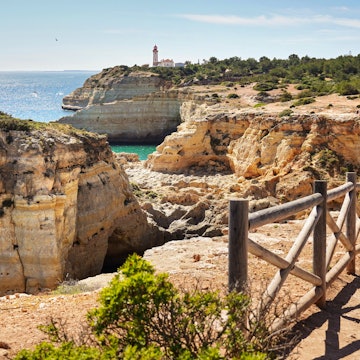

An evening scene in Alfama, Lisbon. Kerry Murray for Lonely Planet
Alfama isn’t just the oldest neighborhood in Lisbon. First established in the 8th century, during the Moorish era, it’s also the oldest in all of Portugal. That it was the only part of Lisbon to emerge almost unscathed from the devastating 1755 earthquake further adds to the district’s time-capsule credentials.
Alfama’s labyrinth-like streets and medieval architecture are completely absent from the central Baixa district just down the hill, which was rebuilt after the earthquake along a tidy grid plan. By contrast, Alfama’s twists and turns provide natural shade and ventilation, while shielding occupants from gusts of wind. Yet beyond such practicalities, its built environment gives Alfama a near-magical quality. You never know what could lie down a steeply set alleyway: from a tiny, discreetly placed music venue to an artisan ceramic shop.
Though many locals have been priced out by rising rents in the district, Alfama still has an enduring population of older Portuguese residents.. At the neighborhood’s many tascas, it is not uncommon to see gray-bearded men tucking into a lunchtime bitoque (steak) and thinly sliced fries served on a stainless steel plate; in the streets, you’ll stumble across makeshift bars where elderly women sell shot glasses of ginginha, a Portuguese cherry liqueur.
A word of warning: by day, Alfama’s narrow streets get packed with camera-wielding visitors on walking tours – which means the crowd-shy should count on arriving early. Yet even at its busiest, there’s always something unexpected to find in Alfama.
If you know where to look.

Getting there and around
Lisbon’s main airport is just a 20-minute car ride from Alfama. Order an Uber or Bolt – both good values in Lisbon – at the airport, or queue at the taxi stand.
Alfama is served by a number of bus routes, including the 734 and 736, which both serve the Chafariz Dentro (Museu do Fado) stop at the base of the hill. Alternatively, you could get the 728 to Praça Comercio and enjoy a scenic 10-minute walk to the center of Alfama via (relatively) flatter shopping streets.
It would be remiss not to mention the famous 28 tram, which connects Alfama with other notable neighborhoods, including Baixa and Graça. Since the word has long been out and long queues often form to board the historic cars, we highly recommend boarding early (before 9am) or late (after 5pm) in the day, and getting on at Praça Martim Moniz, where the tram starts (and which is conveniently served by a metro station). The queue also tends to be shorter at the Miradouro Portas do Sol stop in Alfama proper. Alternatively, try getting the 12E tram, which you can also board at the Portas do Sol stop – it takes more or less the same route and is much less crowded.
Once you’re in Alfama, count on walking everywhere within the compact district – and be prepared for steps and steep streets.

Where to stay
Alfama offers a range of accommodation options, from hotels that occupy historic buildings to cheap and cheerful hostels – all located close to the action.
Save
For a budget stay, Inn Possible Lisbon Hostel is a great choice, offering private rooms, free breakfast and a central location minutes away from Castelo de São Jorge.
Spend
Hotel Convento de Salvador, which gets its name from its previous incarnation as a late-14th-century convent, is a well-located and reasonably priced option. Look for beautiful architectural details and artistic touches, including azulejo tiles.
Spend More
Housed in a former shoe-polish factory, Memmo Alfama is an adults-only boutique hotel with a rooftop swimming pool and rooms that offer a view of the Tagus river.
Where to get coffee
On the way to Castelo de São Jorge, Pastelaria Santo António serves delicious pastéis de nata, as well as doughnut-like bolos de Berlim and coconut-based pão de deus. Order a meia de leite (half milk) coffee or simple espresso if you’re keen to do things the local way. Since the spot can sometimes fill up with visitors on walking tours, consider the Alfama branch of Copenhagen Coffee, which has a hidden garden set along the tram line.

Where to eat
There’s no need to splash out cash eating out in Alfama, and some of the most delicious offerings won’t run you much – if you know where to find them, that is. Ludo’s is a relaxed spot for brunch in a quiet courtyard, with a varied menu including a guisado bowl (lentils cooked with port wine) and a Middle Eastern–inspired grain bowl. If you stop in later in the day, the Camembert and honey is also delightful, as are the specialist dragonfruit cocktails (made with locally sourced produce).
Carnivores will be keen to grab a bifana, the sandwich made with marinated, thinly sliced pork. (It became famous worldwide thanks to Anthony Bourdain.) Hole-in-the-wall spot As Bifanas do Afonso is the right place to enjoy these – and while you may have to queue a bit, you won’t go hungry.
For dinner, Taberna Sal Grosso, with rustic-style seating and stone walls, is a firm favorite among locals. A chalkboard menu lists seasonal dishes as well as a few evergreen options – of the latter, do not miss polvo com batata doce (octopus with potatoes). Then there’s Taverna das Marias, a recently opened spot where you can try a platter of such Portuguese favorites as lupin beans, and cod with chickpeas. (It’s normally priced for two or more, though there is an option for one, which solo diners will appreciate.)

What to do
Alfama is famed for its fado, Portugal's traditional, mournful, ballad-style music. Fado is typically enjoyed in silence, allowing listeners to savor every note, and sung only in Portuguese, its heartfelt lyrics paired with accompaniment from two or three guitars (one of which will be a 12-string Portuguese guitarra).
First, do your homework: the Museu do Fado provides a crash course in this signature music tradition. Fado tends to be paired with dinner, though the food on offer at many places can be hit or miss. Which is why we recommend Alma do Fado, where must-try dishes include the flambéed chorizo and octopus rice (the vegetarian equivalent is also delicious). For a more intimate feel, try A Baiuca or Dona Amalia. All these restaurants are within a close radius of one other.
Another site worth visiting is Castelo de Sao Jorge, a 6th-century fortress offering panoramic views over the city (book ahead to skip queues). If you don’t fancy a ticketed activity, instead visit Santa Luzia, a popular miradouro (viewpoint) with more perspectives over the city, a stunning pergola and numerous buskers.
Where to shop
If you’re after azulejo tiles, head to XVIII – Azulejo & Faiança, a vast store where you can witness craftspeople painting their creations by hand on site. The offering here extends from both patterns both traditional and less so. (I once saw a tile decorated with the word “cannabis” and associated motifs for sale.) For a unique souvenir, artist R Godoi sells his creations – such as a 3D “sardine can” painting with an actual can attached to the canvas – on the steps of Igreja de Santa Luzia.
Beauty lovers will want to visit the historic flagship of Benamôr, a franchise store selling cosmetics made with all-natural, Portuguese-sourced ingredients. Slather yourself in samples aplenty, including a range scented with flowers from the jacaranda tree, commonly seen all over Portugal.

My favorite thing to do in Alfama
For an extra-special evening, book yourself a seat in Tejo Bar, where a rotation of local musicians perform to an engrossed audience in a tiny, intimate space. Once you find it, you’ll need to knock on the inconspicuous-looking door and pay a discretionary contribution to be let in (€5-10 is usual). Inside, you can enjoy cocktails, petiscos (Portugal’s version of tapas) and an eclectic range of music, from blues to Brazilian bossa nova to more fado.
What to know about safety and etiquette
While Lisbon has a relatively low crime rate, pickpocketing can happen in tourist-heavy areas such as the tram queue at the Martim Moniz tram stop. Tipping in Portugal is not compulsory, but a tip of 5 to 10% of the total bill will always be appreciated.
What to prebook
It’s time to get planning, as several of the places I’ve mentioned will require advance booking, including Tejo Bar (at least a week ahead), Taberna Sal Grosso (which can book up to a month in advance) and the fado restaurants.

What to pack
Lisbon is famed for its calçada portuguesa street tiles, which are both aesthetically delightful and very, very slippery. Since the effect is compounded by Alfama’s steep terrain, make sure you take your most comfortable shoes, and ones that have a good grip (locals favour rubber-soled sneakers).
Which time of day to visit
While there’s lots to like about Alfama by day, evening is when the neighborhood comes into its own. As you meander down its lamp-lit streets filled with fado music, expect the ultimate in romantic ambiance.
















